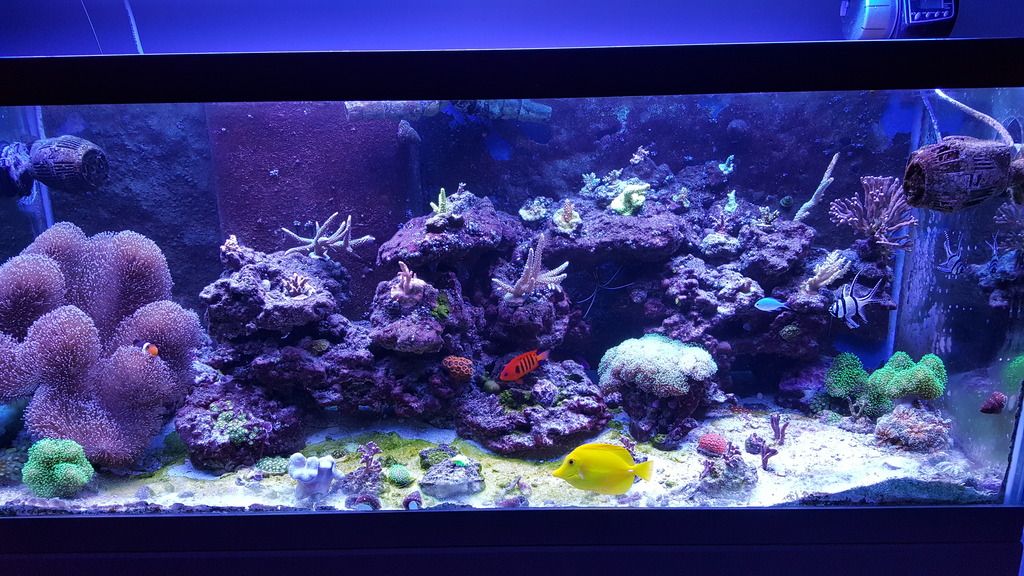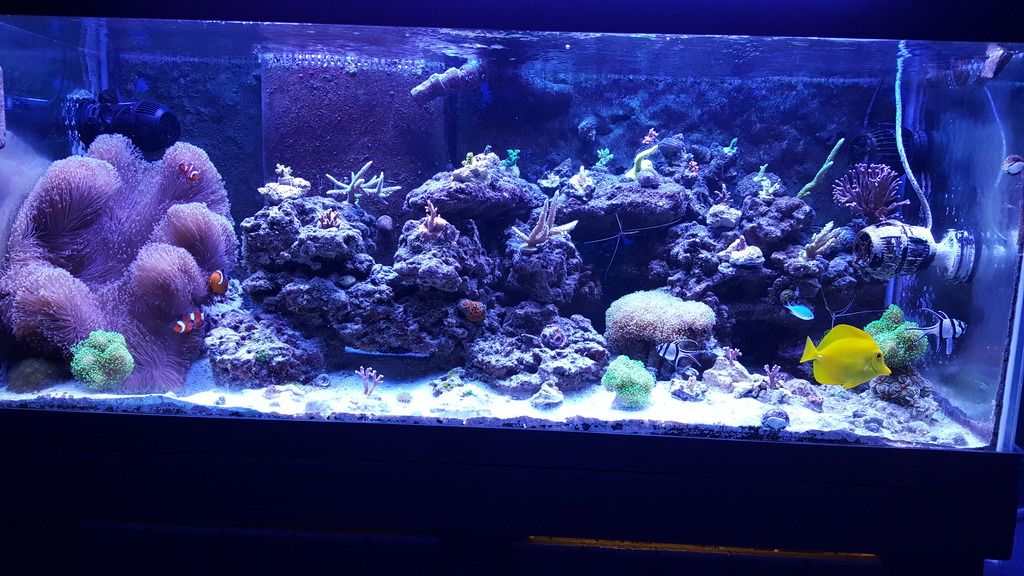http://www.advancedaquarist.com/2002/11/chemistry
http://www.reefcentral.com/forums/showthread.php?t=1297225
http://www.advancedaquarist.com/2016/9/aafeature
I came across the last thread where Randy Holmes was soliciting observations about the effects of high alkalinity on corals. After reading the article, I became fairly convinced that many corals suffered from burnt tips. The alk steadily rose in the tank from about 8 dkh to about 11-12 over a 3 week period. This was caused by having trouble dialing in my dosing pumps, an algae bloom caused by me adding hot water when my return pump stopped and tank cooled. The water was NOT RO water. In any case, either the cold water or my correction caused coral growth to slow considerably, which resulted in alk climbing as the dosing pump continued to add more than was usually consumed.
I wasn't really concerned about the rising alk because it was still within the accepted range of 7-11 dkh. See first link. But in reading the RC thread, it seems clear that some can keep alk at 11 while others suffer burnt tips. A recent article in Advanced Aquarist explored this issue, but didn't reach a conclusion. See third link. I haven't read anything that explains why some can keep the tank at 11 dkh, while others suffer problems.
For sake of research I have noted the effect on my creatures. Not all creatures suffered signs of trauma. The LPS and zoanthid had no reaction. the Acans seem to recede after I corrected the alk to 8. The SPS are listed by name, as purchased.
Glowstix - no effect
Bonsai - no effect
Forest fire digitatus - no effect
Red planet - no effect
Strawberry shortcake - no effect
Upscale microclados - no effect
Bubble gum milli - no effect (maybe paler)
Neon green milli - no effect (maybe paler)
Ultimate Blue staghorn - seems to have paled, but not showing burnt tips
Blue Rim tenius - burnt tip
green slimer - burnt tip
Ora Hawkins Enchinata - burnt tip
Joe the Coral - burnt tip
Purple Slimer - burnt tips
Purple acro - base and internal stems burnt, but not tips
2 Setosa - burnt edges
Lime in the Sky Slimer - severely affected (may die...has some remaining color)
Blue acros - severely affected (probably going to die)
Acro (thought was red planet until it turned turquoise) - severely burnt, likely going to die
Reef exotic rainbow - severly burnt, probably going to die.
The ones that fared the best are all in high light areas - center up high. However, some that did not fair well are right next to them.
So for me, I have decided to keep my alk at 8-9 and take action if elevates higher. Ca at 440. Mag at 1290. SG at 1.024-1.025. All corals have a fairly high flow (2 1500 Koralias, Jebao pp8 at max on pulse, 500 gal return) on a standard 75. Lights are ATI 6 bulb t5 (3b+,1 coral+, 1 actinic, 1 purple).
I have a refugium and bubble algae in display. My old P test said zero phosphates. I recently changed refugium bulbs from a 3000k LED, to a 5100K LED, to a 6500 K cfl. (1200 lumens)
Thinking that phosphates were a problem, I bought GFO, a reactor for GFO/carbon and a hanna checker. Hanna shows 0.0 phosphates (checked twice - is that possible?). Installed BRS reactor with 1/4 cup gfo and 2 cups carbon. No noticeable effect of reactor after 1 week.
I guess I am curious if others have had consistent findings. What effects of high alk have you noticed, if any? Studies suggest that elevated alk can increase growth, but not in my tank...
http://www.reefcentral.com/forums/showthread.php?t=1297225
http://www.advancedaquarist.com/2016/9/aafeature
I came across the last thread where Randy Holmes was soliciting observations about the effects of high alkalinity on corals. After reading the article, I became fairly convinced that many corals suffered from burnt tips. The alk steadily rose in the tank from about 8 dkh to about 11-12 over a 3 week period. This was caused by having trouble dialing in my dosing pumps, an algae bloom caused by me adding hot water when my return pump stopped and tank cooled. The water was NOT RO water. In any case, either the cold water or my correction caused coral growth to slow considerably, which resulted in alk climbing as the dosing pump continued to add more than was usually consumed.
I wasn't really concerned about the rising alk because it was still within the accepted range of 7-11 dkh. See first link. But in reading the RC thread, it seems clear that some can keep alk at 11 while others suffer burnt tips. A recent article in Advanced Aquarist explored this issue, but didn't reach a conclusion. See third link. I haven't read anything that explains why some can keep the tank at 11 dkh, while others suffer problems.
For sake of research I have noted the effect on my creatures. Not all creatures suffered signs of trauma. The LPS and zoanthid had no reaction. the Acans seem to recede after I corrected the alk to 8. The SPS are listed by name, as purchased.
Glowstix - no effect
Bonsai - no effect
Forest fire digitatus - no effect
Red planet - no effect
Strawberry shortcake - no effect
Upscale microclados - no effect
Bubble gum milli - no effect (maybe paler)
Neon green milli - no effect (maybe paler)
Ultimate Blue staghorn - seems to have paled, but not showing burnt tips
Blue Rim tenius - burnt tip
green slimer - burnt tip
Ora Hawkins Enchinata - burnt tip
Joe the Coral - burnt tip
Purple Slimer - burnt tips
Purple acro - base and internal stems burnt, but not tips
2 Setosa - burnt edges
Lime in the Sky Slimer - severely affected (may die...has some remaining color)
Blue acros - severely affected (probably going to die)
Acro (thought was red planet until it turned turquoise) - severely burnt, likely going to die
Reef exotic rainbow - severly burnt, probably going to die.
The ones that fared the best are all in high light areas - center up high. However, some that did not fair well are right next to them.
So for me, I have decided to keep my alk at 8-9 and take action if elevates higher. Ca at 440. Mag at 1290. SG at 1.024-1.025. All corals have a fairly high flow (2 1500 Koralias, Jebao pp8 at max on pulse, 500 gal return) on a standard 75. Lights are ATI 6 bulb t5 (3b+,1 coral+, 1 actinic, 1 purple).
I have a refugium and bubble algae in display. My old P test said zero phosphates. I recently changed refugium bulbs from a 3000k LED, to a 5100K LED, to a 6500 K cfl. (1200 lumens)
Thinking that phosphates were a problem, I bought GFO, a reactor for GFO/carbon and a hanna checker. Hanna shows 0.0 phosphates (checked twice - is that possible?). Installed BRS reactor with 1/4 cup gfo and 2 cups carbon. No noticeable effect of reactor after 1 week.
I guess I am curious if others have had consistent findings. What effects of high alk have you noticed, if any? Studies suggest that elevated alk can increase growth, but not in my tank...



